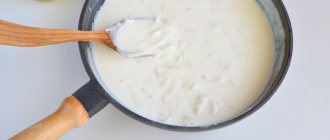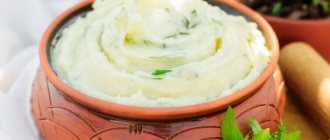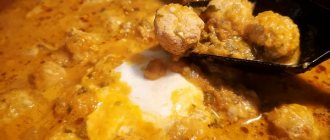Couscous is a delicious dish that came to our country from the East. The world knows the cereal under this name, from which many eastern peoples prepare amazing pilaf with fruits, vegetables, and spices. The benefits of couscous are hidden in the fact that the cereal is made from durum wheat using a special technology.
Cooks from all over the world have invented a lot of recipes for preparing delicious dishes. You can prepare salty and hot, spicy and sweet dishes, as well as numerous cereal-based snacks. It is interesting that in ancient times in the East, only women were allowed to make couscous, who sprinkled grains of semolina with water. After that, they were sprinkled with dry cereal and rolled into miniature balls by hand.
Useful properties of couscous
Couscous is a nourishing and healthy product that increases hemoglobin levels, but, on the contrary, reduces the level of “bad” cholesterol in the blood. Due to the fairly high copper content in porridge, it prevents the development and occurrence of joint diseases, and also promotes the production of female sex hormones.
Couscous is also useful because it contains B vitamins. Thus, vitamin B5 helps to survive stressful situations, as well as get rid of depression, insomnia, chronic fatigue syndrome and irritability.
In order to improve the regeneration of skin cells and hair, increase immunity, the body's resistance to various diseases, increase vitality, and simply improve your mood, you need to include tasty porridge in your diet.
Also, the vitamins that couscous is rich in will be an excellent prevention of premature aging, as well as the early appearance of gray hair.
This is a fairly high-calorie, nutritious and satisfying porridge. It is recommended to be consumed by people engaged in heavy work; this dish is also useful for elderly people, athletes, and growing bodies.
This porridge has a medium glycemic index. This means that it is absorbed by the body gradually, and the glucose level also gradually increases. It is for this reason that it is recommended to include couscous in the menu for diabetics and people suffering from metabolic disorders. If you regularly consume porridge, experts say that the risk of developing diabetes is significantly reduced.
10:25
The unusual name “couscous” came to us from the Middle East and Africa, where dishes made from this product are still popular.
This exotic name hides well-known wheat groats, for the preparation of which millet was previously taken. Now it is made from semolina obtained from durum wheat.
In appearance, it is similar to ordinary rice, and the size of its grains is no more than 1-2 mm.
How to choose wheat, rice or barley couscous
To get the maximum benefit from introducing it into your daily menu, you need to choose it carefully.
.
Today, there are many varieties in stores, and some of them are made on the basis of not only traditional flour, but also flour based on whole grains (when grinding it is not cleaned, but completely preserves the grain germ, endosperm, and husk).
The last option is more natural, healthier, contains almost 2 times more protein and fiber, although it will cost more.
- When buying cereal, pay attention to its composition on the packaging. It is often made from not only durum wheat, but also barley or rice;
- Check to see if the product contains any unwanted artificial additives. The ideal one contains only two components: cereal (the type of flour/cereal from which it is made is indicated on the packaging) and water;
- try to choose cereals in completely sealed packaging: they quickly absorb unwanted odors and moisture;
- if you constantly don’t have enough time to cook, buy steamed cereal, which cooks surprisingly quickly;
- Stores in Arab countries often sell unsteamed couscous or its exclusive handmade analogue. Homemade cereals are stored for only a short time - a month or two. For long-term storage, it is better to take a well-dried and crumbly product.
How to choose couscous in a store:
What it is?
Couscous is a cereal that is made from millet grains, semolina, wheat, barley or others. These grains are coated with a thin layer of flour, resulting in the formation of larger and rather dense particles. Traditionally, couscous was prepared by women.
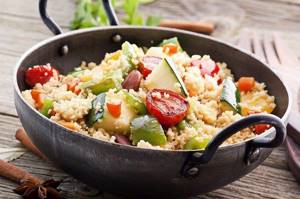
First, they sprinkled semolina grains with water, then rubbed them with their hands until larger lumps formed, which were then dipped in flour or semolina. Next, the couscous is sifted on a sieve and dried.
Such procedures can be repeated several times. After all these actions, balls of golden or yellowish color are formed, having a diameter of 1.5-2 millimeters. Today, the manufacturing process is mechanized, and many different varieties can be found in stores.
Composition, calorie content, nutritional and energy value
Couscous is a real treasure trove of nutrients
, vitamins and microelements. 100 g of product contains:
100 g of ready-made cereal contains almost a quarter of the daily requirement of copper that we should consume
along with food.
Calorie content is 376 kcal per 100 g, which makes it quite filling, but eliminates the possibility of gaining excess weight even with frequent use.
Glycemic index
the whole grain product is 45, and the one based on it is 65.
This is an average value, which says that blood sugar levels will increase gradually, so the risk of getting sick among connoisseurs of this cereal is minimal.
Useful properties of porridge
When you include couscous in your daily menu, you will soon forget about many health problems
. Among them:
- loss of strength, decreased tone;
- neurotic disorders;
- insomnia;
- chronic fatigue syndrome;
- depression.
These properties are explained by the high content of vitamin B5.
It is responsible for cell regeneration
skin, hair, which allows you to maintain the freshness and elasticity of the skin for a long time, and prevent early graying.
With regular consumption of cereals, the level of hemoglobin in the blood increases
, but the content of “bad” cholesterol in it will decrease.
Dishes made from it strengthen the immune system and are quite filling: those who work hard jobs should prefer this cereal to other cereals.
The chemical composition of the product helps:
- speed up metabolism;
- normalize water-salt metabolism;
- cope with foci of infection, eliminate inflammatory processes;
- stimulate brain activity.
Couscous - what is it, what are the benefits, possible harm of cereals for the body? The “Live Healthy!” program answers these questions:
How is this cereal beneficial or harmful?
The product will be quite useful at any age
, but you need to find out the rules of use in advance. This will avoid the negative consequences that sometimes occur among couscous lovers.
The cereal has a delicate taste and restores many impaired body functions.
There are also contraindications for including dishes from it in your diet,
but differ for different age categories.
For adult men and women
Benefits for adults:
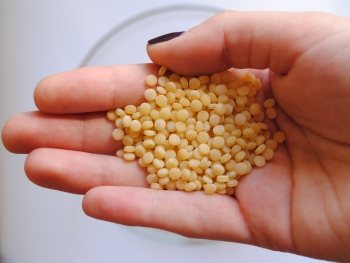
- improves the functioning of the cardiovascular system, prevents myocardial infarction, heart failure, and other serious diseases;
- has a positive effect on memory and concentration;
- will be a good prevention of exacerbation of gastrointestinal diseases due to its enveloping and astringent properties, will improve kidney function;
- normalizes hormonal levels, the production of estrogens - female sex hormones;
- will give you a boost of vigor and energy for a long time.
However, despite the not very high glycemic index, patients with diabetes should eat couscous with caution.
: consuming it in large quantities can provoke an exacerbation of the disease.
Individual sensitivity to the product, excess weight
(subject to a menu high in fat and carbohydrates) - risk factors; may cause unwanted allergic reactions or obesity.
For pregnant and lactating women
An indispensable product for pregnant and nursing mothers.
It contains a sufficient amount of folic acid, which is involved in the formation of nucleic acids that carry information about heredity, which prevents serious malformations in the fetus.
Breastfeeding mothers can eat cereal every day
: it saturates breast milk with all the necessary vitamins and microelements, improves the functioning of the gastrointestinal tract and increases the number of red blood cells in the blood and increases the production of the “hormone of joy” - serotonin.
There are no contraindications, except for individual sensitivity.
For children
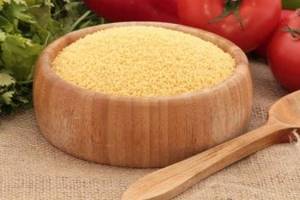
Is couscous good for children? Definitely! Since cereal dishes help strengthen the immune system, children should be given them in the autumn-spring season
when immunity is almost zero, and the risk of catching a cold or contracting the flu is very high.
Hearty main courses or salads with couscous will allow your baby to recharge with energy for a long time and continue to lead an active lifestyle.
The product has a positive effect on brain activity,
Recommended for schoolchildren of any age: improves memory, concentration, increases efficiency, concentration.
Contraindications: diabetes of any degree, tendency to allergies, obesity.
For the elderly
The product contains high concentrations of copper
. This makes dishes made from it a good preventive measure that prevents:
- joint diseases;
- premature skin aging;
- graying of hair;
- digestive disorders in older people;
- fragility of bones.
But with obesity, hormonal disorders associated with menopause, or endocrine diseases, it is still better for older people not to abuse cereals
.
The program “About the Most Important Thing” will tell you about the benefits and potential harm of cereals:
Contraindications and precautions
If you feel unwell after eating couscous
(weakness, headache, nausea), allergic rashes appear on the skin, for now such dishes should be excluded from the menu.
If you have diabetes, you cannot eat cereal every day: it still contains a lot of carbohydrates that can increase blood glucose levels if you are predisposed to the disease.
A product made with wheat can cause an allergic attack.
in people with individual gluten intolerance. Then it’s worth buying cereals based on barley or rice.
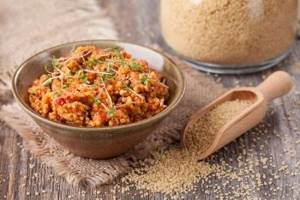
Couscous is still a traditional dish in eastern countries, where it is mainly steamed.
. This prevents the destruction of beneficial substances contained in the product and preserves its vitamin value.
Do not exceed the average consumption rate of the product ( 100–300 g per day
) due to its high calorie content.
However, the product is also used in folk recipes that have come down to us from time immemorial. It is included in home remedies for both external and internal use, used in the treatment of diseases.
In cooking
Couscous is consumed boiled
. To do this, it is prepared as follows: the easiest way is to boil the cereal in water to which 1 tbsp has previously been added. a spoonful of butter, in a ratio of 1:2.
Steam the cereal
. To do this, pour it dry into a colander and hold it for 20-30 minutes over boiling water or broth.
Make a stew with vegetables
. Pre-boil the cereal, and then mix it with lightly fried onions.
It is permissible to place the couscous in a saucepan with vegetables about two minutes before they are ready, pour in the broth so that the cereal is completely covered with it.
After cooking, you can also fry the product in vegetable oil or simply pour boiling water over it for about a quarter of an hour - the cereal will turn out tasty and crumbly.
Soups, desserts, main courses, salads are prepared from it.
, since couscous is combined with meat, fish, stewed vegetables, and seafood. For seasonings, use tarragon, lovage, basil, etc.
Couscous “7 vegetables”, recipe from Eat TV:
For weight loss
Is couscous good for weight loss? Losing extra pounds with couscous is easy
. This dish is relatively low in calories, but very nutritious, satisfies hunger well, and prevents obesity.
The product is a component of many diets due to the fiber it contains in large quantities.
Reduces the production of ghrelin, a hormone responsible for the feeling of hunger. It’s now easier not to think about the problem of overeating!
To forget about extra pounds, prepare dishes according to the following recipes:
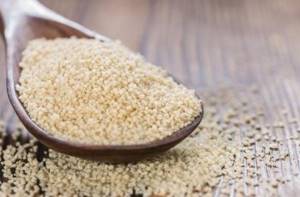
- Pour 1 glass of cereal with 2 glasses of water, boil over medium heat for 15 minutes with constant stirring.
This dish is combined with lean meats, stewed and fresh vegetables, and seafood. It will satisfy your hunger, but will help you avoid gaining excess weight; - take 200 g, 1 pc. , and zucchini and 150 g of cereal. Wash the vegetables, remove the core from the pepper, cut into small cubes. Pour 2 tbsp into the frying pan. spoons of vegetable oil, simmer the vegetables over low heat until soft.
Boil 250 ml of salted water, pour boiling water over the cereal, add 1 tbsp. spoon of sunflower oil and leave to brew for about 10 minutes.Combine porridge with vegetables. A nutritious, low-calorie breakfast or lunch is ready;
- peel 500 g carrots and one onion. Cut the carrots into slices no thicker than 1 cm, and the onion into small slices. Wash 3 sprigs of cilantro, dry, disassemble into small branches.
Place the onion, carrots, 4 unpeeled cloves and half the cilantro in a shallow baking dish and top with 2 tbsp. spoons of vegetable oil and balsamic vinegar.Wrap the vegetables in foil, place in the oven, and bake for 15 minutes at 220°C. Remove the foil and leave them to simmer for about a quarter of an hour.
Then mix the baked vegetables with porridge, steamed or in the usual way from 350 g of cereal, sprinkle with the remaining cilantro, salt and pepper, and serve.
In folk medicine
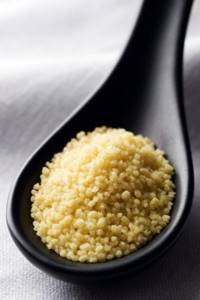
To boost immunity and forget about acute respiratory infections and flu forever
, you can prepare special vitamin mixtures that increase the body’s resistance to viruses and are effective for diseases of the respiratory system.
Lemon and mint mixture
. Salt 200 g of cereal to taste and add freshly boiled water. Close the lid, and after 30-40 minutes add the juice of half a lemon, finely chopped mint leaves and red pepper, mix everything well.
It is enough to eat such a dish once a day or two because of its spiciness - diseases will bypass your home.
Mix the root with 500 g of couscous, pour boiling salted water. Then leave the mixture to steam for 10 minutes until cooked.
In cosmetology
High-quality cereals are a completely natural product made from natural grains and can be used in cosmetic procedures.
rejuvenation and regeneration of the skin of the face and body.
Couscous is often included in pharmaceutical scrubs and peels. At home, masks are prepared from it by mixing boiled cereal with lemon juice, fermented milk products, egg, and honey in equal proportions.
For those who want to always be beautiful, the following recipes will be useful.
To keep your facial skin firm and toned
, pour 100 g of cereal with a glass of water, boil for about 10-15 minutes until the porridge becomes crumbly and soft.
Then mash it well with a fork, mix with the same volume of sour cream or kefir. Stir the mixture thoroughly and apply it to your face for 20-30 minutes. Rinse off with warm water.
Apply the finished mask to the nail plates using rubbing movements, wrap with cling film, leave for about half an hour, and rinse.
This product simply has to live in your kitchen.
along with rice and other cereals. Couscous is an original and healthy dish that will give you good health and well-being.
Calories, kcal:
Proteins, g:
Carbohydrates, g:
The cereal comes from Morocco (North Africa), where the dish of the same name is considered national. But it is no less popular in Tunisia, Tripolitania, Libya, and Algeria.
The name kus comes from the Berber seksu
, which means well-rolled, and translated from Algerian means “food,” which speaks to the everyday nature of this dish. This is because it is a staple food in the Maghreb (particularly Morocco, Libya, Tunisia and Algeria). Couscous is also common in France, Italy, Israel and some regions of the Middle East. In our country, it appeared relatively recently. Therefore, it is still little known and has not been tested by many Russians.
Traditionally, couscous is made from small durum varieties. Often used for its manufacture, and even. Its production technology is similar to the production of pasta (though very small - 0.5-2 mm). The grains with a diameter of 1.2 mm are most actively used in cooking.
As mentioned above, couscous is made from various grains, but wheat couscous is the most common. In addition to its benefits, couscous has wonderful taste, which is incredibly different from the original product (), has a delicate, crumbly consistency and golden color.
Calorie content of dry couscous
The calorie content of dry couscous is 376 kcal per 100 grams of product.
Composition and beneficial properties of dry couscous
Let us note the beneficial properties of the dry couscous product. A significant part of the composition of wheat couscous is complex carbohydrates and protein. It is very rich, which is useful for a general decrease in vitality, chronic fatigue, depression, and insomnia. It also contains quite a lot of dietary fiber, which is responsible for the normal functioning of the gastrointestinal tract, stabilization of water-salt metabolism and brain activity.
Thus, couscous is indicated for people with weak immunity and low hemoglobin, and it is also simply an ideal dietary product (that is, it is suitable for overweight people).
Dry couscous in cooking
Dry couscous is traditionally steamed (ideally in). Any meat or vegetables are cooked in the lower container, and couscous (calorizer) is soaked in aromatic steam in the upper one. It can be served either cold or hot.
Couscous is a high-calorie grain that goes well with fish, seafood, vegetables, meat, fruits (dried fruits), nuts and seasonings.
Couscous is a staple dish in Eastern cuisine. In countries such as Libya, Algeria, Israel, Tunisia and Morocco, this cereal comes first in a healthy diet, because couscous is prepared from grain crops.
The benefits and harms of couscous are discussed in detail in this article. Many nutritionists around the world have agreed that couscous is a storehouse of vitamins and minerals necessary for the human body.
Famous chefs say: in addition to the fact that this cereal is very healthy to eat, its preparation is a whole ritual. While preparing couscous, a person receives a boost of energy from the thought that a delicious and valuable product is being prepared, which will provide great benefits to those who will eat a variety of dishes, from side dishes to delicious desserts. In modern times, couscous is mainly made from wheat grain. And earlier it was millet.
Couscous with chicken and vegetables - step-by-step recipe
Couscous with vegetables and chicken, prepared according to our recipe, is most similar to a salad. But at the same time it is nutritious and satisfying enough to replace a full lunch or dinner. On a note! Lovers of spices and herbs will have complete freedom in preparing couscous. Basil, thyme, thyme, marjoram and oregano perfectly complement dishes with couscous and give them an unusual taste and aroma. Dried apricots, figs, cranberries, nuts and citrus fruits also combine amazingly well with this product.
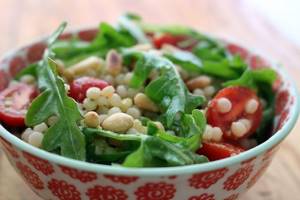
Required ingredients:
- olive oil - 3 tbsp. l.
- couscous - 2 cups
- boiling water - 2 cups
- pesto sauce - 50 gr.
- boiled chicken fillet - 1 pc.
- salt
- lemon juice - 30 ml.
- Cherry tomatoes - 7 pcs.
- pine nuts - 30 gr.
- arugula
Step-by-step instruction
- How to cook: To prepare couscous, fry it in a deep pan with olive oil. Then add water, add salt and cook until done under the lid. After 10-15 minutes, discard the cereal in a colander and rinse with running cold water. Drizzle with olive oil again and leave to cool in a deep container.
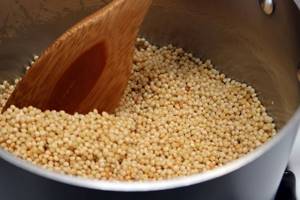
- In a separate bowl, mix pesto, a pinch of salt and lemon juice. Pour the resulting mixture over the couscous. Leave to soak at room temperature for 40-60 minutes.
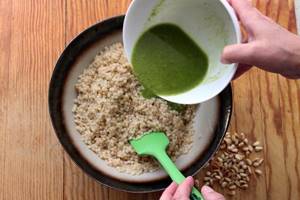
- Cut the chicken breast into cubes and the cherry tomatoes into halves. Before serving, add tomatoes, meat and arugula to the couscous and mix thoroughly. Garnish the dish with toasted pine nuts.
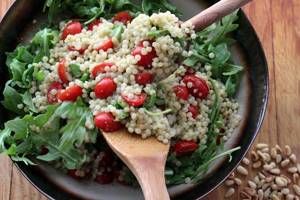
Couscous - composition and calorie content
100 grams of couscous contains:
- carbohydrates
in the amount of 22 g (this is approximately 17% of the daily value); - dietary fiber
- 1.5 g (7%); - proteins
- 3.8 g (4.65%); - fats
- 0.2 g (0.3%); - calories
- 110 kcal (7.8%).
The cereal contains a variety of vitamins (mainly), but in small quantities from the daily value:
The cereal also contains a small amount of minerals:
- iron,
- phosphorus,
- zinc,
- copper,
- potassium,
- magnesium,
- manganese.
The exception is selenium,
of which 28 mcg per 100 g of product, which is half the daily requirement for this microelement.
How to cook couscous with milk
Step-by-step recipe description
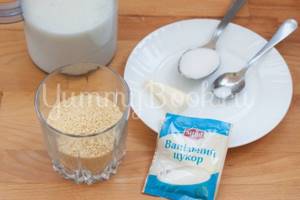
1. Ingredients you will need for the porridge.
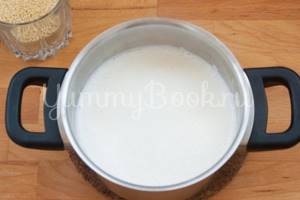
2. Pour milk into a small saucepan or saucepan and bring to a boil. Add salt, sugar, vanilla sugar and mix. Remove the pan with milk from the stove.
Couscous benefits and harms
Useful properties of couscous
It is known that the peoples of the East used couscous back in the 13th century, so it is not surprising that they, like no one else, are familiar with its not only excellent nutritional properties, but healing ones. This cereal is successfully used in the treatment of many diseases.
Couscous is indicated for people who tend to become depressed, as well as those who are very overworked with work and various worries. It treats sleep disorders and many nervous disorders. You may ask, how can any cereal help improve such conditions? It's very simple, this happens thanks to the large amount of vitamin B5 contained in couscous - which benefits the body.
In order to preserve all the beneficial vitamins and minerals in couscous when cooking, do not throw it into water, as they may be destroyed. It is best to steam cereals, then it will be a real gift to your health. Copper present in couscous helps the body, by replenishing its reserves, normalizes hemoglobin levels, prevents the development of many joint diseases and leaves your hair gray-free for a long time. Thanks to the same copper that enters the human body as part of couscous, women’s sex hormones return to normal, which means that this cereal prolongs the health and beauty of the fair half of humanity.
During the cold season, couscous successfully fights infectious diseases, improves body tone, which promotes an active lifestyle. For those whose dream is to lose weight, couscous is just a godsend. It is rich in fiber, without which the body will not fight excess fat. Microelements in couscous speed up the digestion of food and normalize the functioning of the large intestine. Regular consumption of couscous promotes productive brain function.
Another benefit of couscous is the following: the potassium and magnesium contained in the cereal are the key to strong heart muscle, which means regular enrichment of the blood with hemoglobin.
People who regularly eat couscous note that hair grows quickly and hair loss decreases. Those whose work requires constant physical effort say that meat with couscous on the side, like nothing else, gives strength and the desire to work further. Couscous is recommended for athletes, as its rich composition increases the body's reserves and gives new victories. This cereal is also indicated for older people who suffer from constipation due to weak intestinal motility. For young children, couscous is diluted with milk and given as a healthy breakfast.
Without any doubt, couscous is a very healthy and nutritious product. But still, despite such a diverse beneficial composition, this cereal, like many other products, has its contraindications. If you do not take into account the points listed below, then couscous will bring not only benefits to the body, but also harm.
Harm of couscous and contraindications
In addition to the benefits, you can get harm from couscous. People suffering from diabetes or a certain stage of obesity should be very careful about couscous dishes and, especially, desserts made from it. The fact is that, although cereals have an average glycemic index of 45, due to their calorie content, they can provoke an increase in blood sugar
.
If a person is overweight and daily consumes unhealthy foods such as sweets, fast food, chips, carbonated drinks and at the same time adds couscous to his diet, then this will only cause harm, which will lead to even more weight gain. It will be better if the couscous is made sweet not with honey or sugar, but with fruit, for example, grapes or peaches. Thanks to this trick, you can minimize the harm of couscous to your figure by enriching the dish not only with fructose, but also with healthy fiber.
The following harms from couscous for people intolerant to gluten:
Some people may be hypersensitive to foods containing gluten, so they may be severely allergic to couscous made from barley or wheat. If you really like couscous and don’t want to give it up at all, then you need to choose rice cereal.
Best dishes
Now you know what it is - couscous. Time to get started with the recipes. We have selected for you only a few of the most popular and not too difficult to prepare.
Salad “Clink of Coins”
If you try a light and satisfying salad with couscous at least once, you will finally be able to understand why Eastern people love this cereal so much. It is better to prepare this dish in the summer, during the ripening season of tomatoes and sweet peppers.
First, you need to prepare the cereal itself - steam it or pour boiling water over it and leave for 20 minutes so that it swells well. While it's cooking, cut the vegetables:
- Cut 200 g cherry tomatoes into halves.
- Cut a dozen green olives into two parts.
- Add sweet peppers and 200 g of cheese, cut into cubes, to the salad bowl.
- We also send herbs here (cilantro, mint, basil). Since not everyone likes cilantro due to its sharp taste, it is added as desired.
- Pour the cooled cereal into the vegetables and add salt to taste. Throw in a handful of cumin (cumin). Sprinkle with lemon juice. Mix.
- Our salad is ready.
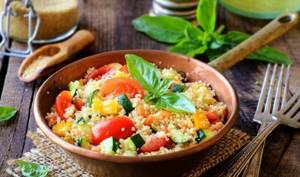
If you try a light and satisfying salad with couscous at least once, you will finally be able to understand why Eastern people love this cereal so much.
Interesting! It is curious that in Australia there is a creature with a similar name. The cuscus animal is a marsupial and is valued not only for its high-quality fur. Local housewives happily prepare all kinds of dietary dishes from its meat.
Soup with vegetables and couscous “Khamsin”
The combination of tender couscous with vegetables gives a very unusual effect. To prepare a light meatless soup under the exotic name “Khamsin” you will need:
- a glass of ready-made couscous;
- glass of water;
- two small sweet peppers (to make our dietary dish bright, it is better to take colored ones);
- eggplant;
- two carrots;
- a small head of garlic;
- spoon of vegetable oil;
- salt;
- any spices: you can take coriander or basil, although their choice depends only on your taste;
- pepper mixture.
Prepared and peeled vegetables are cut into small cubes. Onions are fried in oil, then the rest of the vegetables, salt, spices are added and water is added. Since carrots, peppers and eggplants cook quickly, 15 minutes will be enough to stew them. Mix the prepared vegetable dressing with couscous.
Chicken and couscous soup
It is quite possible that this light couscous and chicken soup will soon become your signature dish. Due to the fact that its recipe includes a minimum of ingredients, its preparation takes a minimum of time.
We only need a few products:
- half a chicken or a couple of hams;
- several potatoes;
- small carrots;
- a handful of couscous;
- water;
- salt;
- any of our favorite seasonings and herbs.
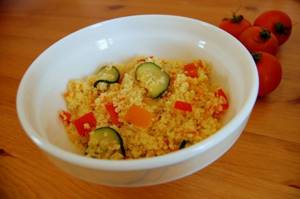
First, cook regular chicken broth over low heat. In order for it to be perfectly transparent, you should not put it on high heat - the water in it should only boil slightly.
Add diced potatoes and coarsely grated carrots into the prepared broth and cook until tender. Add couscous and herbs at the very end of cooking. Turn off the oven, simmer the dish for another ten minutes and call the whole family to the table.
Advice! Couscous soup is very good not only hot, but also cold.
Couscous garnish
It will take no more than 20–30 minutes to prepare this side dish. To prepare it we take the following ingredients:
- a glass of couscous;
- water 2 glasses;
- salt;
- 1 piece of onion and carrot;
- curry seasoning, you can replace it with a mixture of turmeric and ginger;
- unsweetened soy sauce.
Since you need to stir ready-made couscous carefully so as not to damage the stuck together grains, it is better to mix the still dry grains with salt and seasoning in advance. Pour boiling water over the mixture and leave for 10–15.
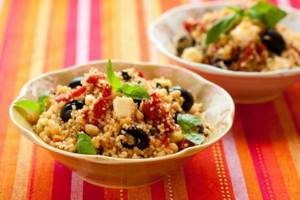
It will take no more than 20–30 minutes to prepare this side dish.
While the porridge is steaming, sauté the onion in vegetable oil, then add the carrots, cover the pan with a lid and simmer until tender. At the end, add steamed couscous and serve our side dish with soy sauce to any meat or fish.
Advice! Be sure to add ginger and turmeric to any couscous side dish. They will give the dish a golden hue and exquisite taste.
Couscous with lamb
Surprise your guests by serving this exotic African dish made with couscous. Although the main recipe contains lamb meat, it can be replaced with chicken, lean pork or beef. In addition to a kilogram of meat, we will need:
- chickpeas (a special type of pea, popular in the east) 60 g;
- rutabaga pre-soaked in water: a couple of pieces;
- 2 large carrots, cut into slices;
- 1 medium-sized onion;
- raisins pre-boiled in a small amount of water;
- vegetable oil for stewing meat and vegetables;
- butter;
- 2 tomatoes;
- dry or chopped ginger;
- saffron;
- 0.5 kg of zucchini or pumpkin;
- 100–150 g green beans;
- pepper (it is advisable to find cayenne pepper, but if you don’t have it, you can get by with red pepper);
- salt.
Cook the couscous in a double boiler or soak it in boiling water. Gently knead the well-steamed cereal with a spoon to remove any lumps that have formed.
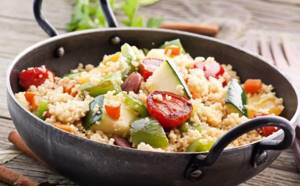
Couscous can be cooked in a steamer or slow cooker
Fill half a finger of water with meat, onions, chickpeas, carrots and rutabaga. Add vegetable oil and pepper there. Simmer them for about an hour until the peas are ready. Next, throw raisins, beans, pumpkin and tomatoes into the pan and cook for about another half hour. Then pour the resulting sauce over the couscous, place the meat on a plate and serve.
Advice! In Egypt, this porridge is considered a healing dish. Local doctors always give it to seriously ill people to restore strength. In those parts it is also recommended for feeding premature babies.
Quick sweet couscous recipe
This golden porridge is also used to prepare some sweet dishes, for example, masfouf - a couscous dish with the addition of grapes, nuts and dried fruits. You can also eat it simply with sugar, syrup or honey.
Let's describe the simplest recipe for sweet couscous. For a glass of cereal you will need a handful of raisins, cinnamon on the tip of a knife, butter, sugar or honey. The cooking process is simple. Steam the porridge, add butter, sprinkle with sugar and cinnamon. Raisins are added ready-made, pre-boiled.
Advice! In the postoperative period, doctors often recommend consuming semolina, which contains it in sufficient quantities, to compensate for iron deficiency. If you're not a fan of this cereal, substitute salads or couscous sides.
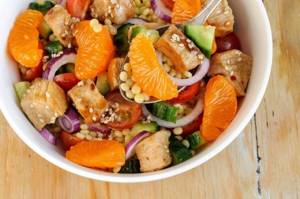
This golden porridge is also used to prepare some sweet dishes, for example, masfouf - a couscous dish with the addition of grapes, nuts and dried fruits.
Couscous in cooking
And now, how to prepare delicious and healthy couscous - one of the best recipes:
In the traditional menu of Algerian, Spanish, Moroccan and even some French restaurants you can see a large number of varied dishes, the main component of which is couscous. This golden, crumbly and very delicate cereal has an excellent taste and goes well with almost all products.
Couscous is a golden grain that vaguely resembles millet, and this product is made from barley, millet, rice and certain varieties of wheat.
The couscous dish, which has the same name as the main component, is a unique type of pilaf, and is prepared with meat, a variety of spices and vegetables.
Couscous can be prepared in different ways: it can be sweet or very spicy dishes, tabbouleh, all kinds of salads and dessert or savory snacks, and much more.
So, for example, you can prepare excellent couscous with an exotic sauce of blood orange and pear. You can also add an excellent and very tasty filling of fruit juice, allspice and wine.
Sweet couscous with allspice and sweet orange
To prepare sweet couscous with allspice and blood orange you will need the following set of ingredients:
- sprigs of fresh peppermint (two pieces);
- couscous (120 g);
- the largest grains of allspice (two pieces);
- white wine (110 ml);
- red orange (four pieces);
- walnut oil (one tablespoon);
- the ripest pears (three pieces);
- sea buckthorn juice (two tablespoons);
- chopped almonds (four tablespoons);
- freshly squeezed lime juice (two tablespoons);
- high-quality honey (two tablespoons).
How to cook couscous:
- First, pour the required amount of couscous into a pre-prepared bowl, after which it should be left to soak in boiling water.
- As soon as the couscous increases in size, cool it by mixing it with additional walnut oil.
- Wash all the ripe pears, cut into fairly thin slices, removing the core. Simmer the pear pieces for five minutes, adding additional honey, allspice, lime and sea buckthorn juice, and white wine.
- Peel the oranges, carefully remove the skin from all the segments, add to the stewed pear pieces, continue to simmer for a little longer, then remove from the stove. Leave the fruit for about thirty minutes so that they are better saturated with the prepared sauce.
- Fry almonds, sliced without adding fat, in a dry frying pan; as soon as a pleasant nutty aroma appears, pour the nuts into a separate bowl. Dry the mint, wash and chop, remove the fruit from the sauce, place on a sieve for about five minutes.
- Mix couscous with sauce (one tablespoon), half of the stewed fruit, arrange the fruit on plates, garnish the prepared oriental dish with fresh mint leaves, fried almond slices, and the remaining half of the fruit.
Couscous has both benefits and harms; it is considered a very tasty and popular dish, especially in Eastern cuisine.
The homeland of this cereal is considered to be Morocco (North Africa), where the dish of the same name is national. However, it is also popular in countries such as Algeria, Libya, Tunisia and Tripolitania.
The name cous comes from the Berber “seksu”, which translates as “well rolled”, while in Algerian the word means “food”, hinting at its everyday occurrence. This can be explained by the fact that it is considered one of the staple foods in the Maghreb (specifically Algeria, Libya, Tunisia and Morocco). Couscous is also widespread in Israel, Italy, France and a number of Middle Eastern regions. It came to Russia relatively recently, therefore it has not yet become so famous and has not yet appeared on the tables of most citizens.
Traditionally, couscous is made from ground durum wheat semolina. Often millet, rice and barley are used for its production. The technique for making it is similar to the production of pasta (however, it is quite small - one and a half to two millimeters). Grains with a radius of 0.6 mm are used with the greatest activity in cooking.
As mentioned above, couscous is obtained from various grains, but most often you can find wheat couscous. In this regard, we will try to talk about the beneficial properties of this product. Most of the composition of wheat couscous comes from protein and complex carbohydrates. It is especially enriched with pantothenic acid, which is very useful for decreased vitality, sleep problems, general fatigue, and depression. Quite a high content of copper, iron, potassium, phosphorus and dietary fiber, which are responsible for the proper functioning of the gastrointestinal tract, normalization of water-salt metabolism and brain function.
The calorie content of couscous is quite high and amounts to 376 kcal; it also contains proteins - 12.8 g, carbohydrates - 72.4 g, fats - 0.6 g.
In addition to its beneficial properties, couscous has an excellent taste, which is radically different from the original product (semolina). It is characterized by a delicate, crumbly consistency and golden color.
Its preparation is carried out mainly by steam (the best option is in a double boiler). Meat products or vegetables are boiled in the lower container, and the couscous itself is cooked in the upper one in aromatic steam. Served both hot and chilled.
Couscous is a high-calorie grain that goes well with meat, nuts, fish, seasonings, seafood and vegetables.
Couscous in a slow cooker
To select by ingredients, enter their names separated by commas, for example: potatoes, beef
Couscous in a slow cooker is a very original and appetizing dish that does not require long preparation. This porridge can be an excellent side dish for any meat, poultry or fish dishes, or if you add a little butter and milk to it, it will become a light and very tasty breakfast. So if you have a brand new or already forgotten multi-cooker languishing in your kitchen, a bag of this bright yellowish cereal is lying around in the pantry and you want to taste its delicate taste, then you can get started!
Ingredients for making couscous in a slow cooker:
- Couscous cereal (regular crushed wheat) - 1 cup
- Purified water 2 cups
- Salt to taste
- Butter to taste
Products not suitable? Choose a similar recipe from others!
Inventory:
Glass (capacity 240 grams), kitchen towel, deep bowl, multicooker, wooden or silicone kitchen spatula, portion plate.
Cooking couscous in a slow cooker:
As soon as the liquid boils, add salt and prepared couscous to taste. Immediately close the kitchen appliance with a tight-fitting lid and set the new “Heating” mode for 15 minutes.
After the multicooker turns off, notifying you with a corresponding buzzing, squeaking or beeping sound, add a little butter to the finished dish. Lightly mix the quickly melting fat with the porridge. It is better to do this with a wooden kitchen or silicone spatula or a special plastic spoon so as not to damage the Teflon coating. Then we keep the aromatic dish in a heated bowl under a tightly covered lid for another 5–10 minutes, and then taste it. After cooking, the couscous in the slow cooker is infused a little and then served hot as a side dish or main course. This porridge can be served in different ways, for example, simply by adding another portion of butter, salad, fried, stewed or baked vegetables, meat, poultry or fish. This dish is very fond of spices: thyme, savory, oregano, basil, marjoram, and mint, especially if served with sea creatures. So ordinary boiled couscous can be safely called an ideal basis for preparing culinary masterpieces. Enjoy and enjoy simple food!
Tips for the recipe:
– after the couscous is ready, it can be infused in a closed steamer along with canned sweet corn or green peas and fresh finely chopped herbs, in this case you will get a slightly complex, but very tasty side dish for fish or poultry;

